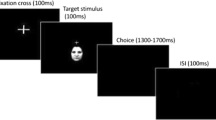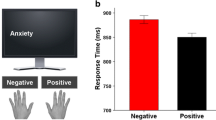Abstract
On the basis of current emotion theories and functional and neurophysiological ties between the processing of conflicts and errors on the one hand and errors and emotions on the other hand we predicted that conflicts between prepotent Go responses and occasional NoGo trials in the Go/NoGo task would induce emotions. Skin conductance responses (SCRs), corrugator muscle activity, and startle blink responses were measured in three experiments requiring speeded Go responses intermixed with NoGo trials of different relative probability and in a choice reaction experiment serving as a control. NoGo trials affected several of these emotion-sensitive indicators as SCRs and startle blinks were reduced whereas corrugator activity was prolonged as compared to Go trials. From the pattern of findings we suggest that NoGo conflicts are not aversive. Instead, they appear to be appraised as obstructive for the response goal and as less action relevant than Go trials.




Similar content being viewed by others
Notes
In this experiment the feedback tone was presented 970 after stimulus onset in order to avoid an overlap between startle and feedback tone.
References
Aue, T., Flykt, A., & Scherer, K. R. (2007). First evidence for differential and sequential efferent effects of stimulus relevance and goal conduciveness appraisal. Biological Psychology, 74, 347–357.
Balle, M. (2002). La loi du moindre effort mental: Les representations mentales. Sciences humaines, 128, 36–39.
Bernat, E., Patrick, C. J., Benning, S. D., & Tellegen, A. (2006). Effects of picture content and intensity on affective physiological response. Psychophysiology, 43, 93–103.
Boucsein, W. (1992). Electrodermal Activity. New York: Plenum Press.
Botvinick, M. (2007). Conflict monitoring and decision making: Reconciling two perspectives on anterior cingulate function. Cognitive, Affective, and Behavioral Neuroscience, 7, 356–366.
Bradley, M. M., Cuthbert, B. N., & Lang, P. J. (1990). Startle reflex modification: Emotion or attention? Psychophysiology, 27, 513–522.
Bruin, K. J., & Wijers, A. A. (2002). Inhibition, response mode, and stimulus probability: A comparative event-related potential study. Clinical Neurophysiology, 113, 1172–1182.
Devinsky, O., Morrell, M. J., & Vogt, B. A. (1995). Contributions of anterior cingulate cortex to behaviour. Brain, 118, 279–306.
Ellsworth, P. C., & Scherer, K. R. (2003). Appraisal processes in emotion. In R. J. Davidson, K. R. Scherer, & H. H. Goldsmith (Eds.), Handbook of affective sciences (pp. 572–595). Oxford: Oxford University Press.
Filion, D. L., Dawson, M. E., & Schell, A. M. (1998). The psychological significance of human startle eyeblink modification: A review. Biological Psychology, 47, 1–43.
Fridlund, A. J., & Cacioppo, J. T. (1986). Guidelines for human electromyographic research. Psychophysiology, 23, 567–589.
Frijda, N. H. (1986). The Emotions. Cambridge and New York: Cambridge University Press.
Gehring, W. J., Himle, J., & Nisenson, L. G. (2000). Action-monitoring dysfunction in obsessive-compulsive disorder. Psychological Science, 11, 1–6.
Gehring, W. J., & Willoughby, A. R. (2002). The medial frontal cortex and the rapid processing of monetary gains and losses. Science, 295, 2279–2282.
Hajcak, G., & Foti, D. (2008). Errors are aversive Defensive motivation and the Error-Related Negativity. Psychological Science, 19, 103–108.
Hajcak, G., McDonald, N., & Simons, R. F. (2003). Anxiety and error-related brain activity. Biological Psychology, 64, 77–90.
Hajcak, G., McDonald, N., & Simons, R. F. (2004). Error-related psychophysiology and negative affect. Brain and Cognition, 56, 189–197.
Hajcak, G., Moser, J. S., Yeung, N., & Simons, R. F. (2005). On the ERN and the significance of errors. Psychophysiology, 42, 151–160.
Hamm, A. O., Schupp, H. T., & Weike, A. I. (2003). Motivational organization of emotions: Autonomic changes, cortical responses, and reflex modulation. In R. J. Davidson, K. R. Scherer, & H. H. Goldsmith (Eds.), Handbook of affective sciences (pp. 135–186). Oxford: Oxford University Press.
Heuer, H. (1982). Choice between finger movements of different and identical form: The effect of relative signal frequency. Psychological Research, 44, 323–342.
Jänig, W. (2003). The autonomic nervous system and its coordination by the brain. In R. J. Davidson, K. R. Scherer, & H. H. Goldsmith (Eds.), Handbook of affective sciences (pp. 135–186). Oxford: Oxford University Press.
Lang, P. J. (1995). The emotion probe Studies of motivation and attention. American Psychologist, 50, 372–385.
Lang, P. J., Bradley, M. M., & Cuthbert, B. N. (1990). Emotion, attention, and the startle reflex. Psychological Review, 97, 377–395.
Lang, P. J., Bradley, M. M., & Cuthbert, B. N. (1998). Emotion, motivation, and anxiety: Brain mechanisms and psychophysiology. Biologial Psychiatry, 44, 1248–1263.
Lang, P. J., Greenwald, M. K., Bradley, M. M., & Hamm, A. O. (1993). Looking at pictures: Affective, facial, visceral, and behavioral reactions. Psychophysiology, 30, 261–273.
Lim, C. L., Gordon, E., Rennie, C., Wright, J. J., Bahramali, H., Li, W. M., et al. (1999). Dynamics of SCR, EEG, and ERP activity in an oddball paradigm with short interstimulus intervals. Psychophysiology, 36, 543–551.
Luu, P., Collins, P., & Tucker, D. M. (2000). Mood, personality, and self-monitoring: Negative affect and emotionality in relation to frontal lobe mechanisms of error monitoring. Journal of Experimental Psychology: General, 129, 43–60.
McSweeney, F. K., & Swindell, S. (1999). General-process theories of motivation revisited: The role of habituation. Psychological Bulletin, 125, 437–457.
Miller, J., Patterson, T., & Ulrich, R. (1998). Jackknife-based method for measuring LRP onset latency differences. Psychophysiology, 35, 99–115.
Nieuwenhuis, S., Yeung, N., & Cohen, J. D. (2004). Stimulus modality, perceptual overlap, and the go/no-go N2. Psychophysiology, 41, 157–160.
Nieuwenhuis, S., Yeung, N., van den Wildenberg, W., & Ridderinkhof, K. R. (2003). Electrophysiological correlates of anterior cingulate function in a go/no-go task: Effects of response conflict and trial type frequency. Cognitive, Affective, and Behavioral Neuroscience, 3, 17–26.
Oldfield, R. C. (1971). The assessment and analysis of handedness: The Edinburgh inventory. Neuropsychology, 9, 97–113.
Pugh, L. A., Oldroyd, C. R., Ray, T. S., & Clark, M. L. (1966). Muscular effort and electrodermal responses. Journal of Experimental Psychology, 71, 241–248.
Reisenzein, R. (2008). Emotions as metarepresentational states of mind: Naturalizing the belief-desire theory of emotion. Cognitive Systems Research.
Russell, J. A., & Barrett, L. F. (1999). Core affect, prototypical emotional episodes, and other things called emotion: Dissecting the elephant. Journal of Personality and Social Psychology, 76, 805–819.
Scherer, K. R. (1984). On the nature and function of emotion: A component process approach. In K. R. Scherer & P. Ekman (Eds.), Approaches to Emotion (pp. 293–318). Hillsdale: Erlbaum.
Scherer, K. R. (2001). Appraisal considered as a process of multi-level sequential checking. In K. R. Scherer, A. Scholl, & T. Johnstone (Eds.), Appraisal Processes in Emotion: Theory, Methods, Research (pp. 92–120). New York: Oxford University Press.
Schupp, H. T., Lutzenberger, W., Rau, H., & Birbaumer, N. (1994). Positive shifts of event-related potentials: A state of cortical disfacilitation as reflected by the startle reflex probe. Electroencephalography and Clinical Neurophysiology, 90, 135–144.
Ullsperger, M., & von Cramon, D. Y. (2004). Neuroimaging of performance monitoring: Error detection and beyond. Cortex, 40, 593–604.
van Veen, V., & Carter, C. S. (2002). The timing of action-monitoring processes in the anterior cingulate cortex. Journal of Cognitive Neuroscience, 14, 593–602.
Vidal, F., Hasbroucq, T., Grapperon, J., & Bonnet, M. (2000). Is the ‘error negativity’ specific to errors? Biological Psychology, 51, 109–128.
Vogt, B. A., Hof, P. R., & Vogt, L. J. (2004). Cingular Gyrus. In G. Paxinos & J. K. Mai (Eds.), The human nervous system (2nd ed ed., pp. 915–949). San Diego: Elsevier Academic.
Yeung, N., Cohen, J. D., & Botvinick, M. M. (2004). The neural basis of error detection: Conflict monitoring and the error-related negativity. Psychological Review, 111, 931–959.
Acknowledgments
We wish to thank Mareike Bayer, Nele Adler, and Guillermo Recio for assisting in data collection, and Rainer Kniesche and Thomas Pinkpank for technical support. This research was supported by the German Research Foundation, Grant No. So 177/17-1 to Werner Sommer.
Author information
Authors and Affiliations
Corresponding author
Rights and permissions
About this article
Cite this article
Schacht, A., Nigbur, R. & Sommer, W. Emotions in Go/NoGo conflicts. Psychological Research 73, 843–856 (2009). https://doi.org/10.1007/s00426-008-0192-0
Received:
Accepted:
Published:
Issue Date:
DOI: https://doi.org/10.1007/s00426-008-0192-0




